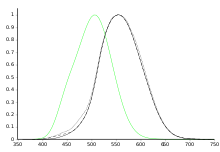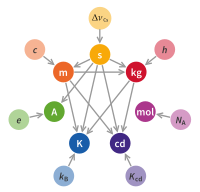Luminous intensity
| luminous intensity | |
|---|---|
Common symbols | Iv |
| SI unit | candela |
Other units | |
| In SI base units | cd |
| Dimension | |
In photometry, luminous intensity is a measure of the wavelength-weighted power emitted by a light source in a particular direction per unit solid angle, based on the luminosity function, a standardized model of the sensitivity of the human eye. The SI unit of luminous intensity is the candela (cd), an SI base unit.
Measurement
[edit]Photometry deals with the measurement of visible light as perceived by human eyes. The human eye can only see light in the visible spectrum and has different sensitivities to light of different wavelengths within the spectrum. When adapted for bright conditions (photopic vision), the eye is most sensitive to yellow-green light at 555 nm. Light with the same radiant intensity at other wavelengths has a lower luminous intensity. The curve which represents the response of the human eye to light is a defined standard function y(λ) or V(λ) established by the International Commission on Illumination (CIE, for Commission Internationale de l'Éclairage) and standardized in collaboration with the ISO. [1]
Luminous intensity of artificial light sources is typically measured using and a goniophotometer outfitted with a photometer or a spectroradiometer. [2]
| Quantity | Unit | Dimension [nb 1] |
Notes | ||
|---|---|---|---|---|---|
| Name | Symbol[nb 2] | Name | Symbol | ||
| Luminous energy | Qv[nb 3] | lumen second | lm⋅s | T⋅J | The lumen second is sometimes called the talbot. |
| Luminous flux, luminous power | Φv[nb 3] | lumen (= candela steradian) | lm (= cd⋅sr) | J | Luminous energy per unit time |
| Luminous intensity | Iv | candela (= lumen per steradian) | cd (= lm/sr) | J | Luminous flux per unit solid angle |
| Luminance | Lv | candela per square metre | cd/m2 (= lm/(sr⋅m2)) | L−2⋅J | Luminous flux per unit solid angle per unit projected source area. The candela per square metre is sometimes called the nit. |
| Illuminance | Ev | lux (= lumen per square metre) | lx (= lm/m2) | L−2⋅J | Luminous flux incident on a surface |
| Luminous exitance, luminous emittance | Mv | lumen per square metre | lm/m2 | L−2⋅J | Luminous flux emitted from a surface |
| Luminous exposure | Hv | lux second | lx⋅s | L−2⋅T⋅J | Time-integrated illuminance |
| Luminous energy density | ωv | lumen second per cubic metre | lm⋅s/m3 | L−3⋅T⋅J | |
| Luminous efficacy (of radiation) | K | lumen per watt | lm/W | M−1⋅L−2⋅T3⋅J | Ratio of luminous flux to radiant flux |
| Luminous efficacy (of a source) | η[nb 3] | lumen per watt | lm/W | M−1⋅L−2⋅T3⋅J | Ratio of luminous flux to power consumption |
| Luminous efficiency, luminous coefficient | V | 1 | Luminous efficacy normalized by the maximum possible efficacy | ||
| See also: | |||||
- ^ The symbols in this column denote dimensions; "L", "T" and "J" are for length, time and luminous intensity respectively, not the symbols for the units litre, tesla and joule.
- ^ Standards organizations recommend that photometric quantities be denoted with a subscript "v" (for "visual") to avoid confusion with radiometric or photon quantities. For example: USA Standard Letter Symbols for Illuminating Engineering USAS Z7.1-1967, Y10.18-1967
- ^ a b c Alternative symbols sometimes seen: W for luminous energy, P or F for luminous flux, and ρ for luminous efficacy of a source.
Relationship to other measures
[edit]
Luminous intensity should not be confused with another photometric unit, luminous flux, which is the total perceived power emitted in all directions. Luminous intensity is the perceived power per unit solid angle. If a lamp has a 1 lumen bulb and the optics of the lamp are set up to focus the light evenly into a 1 steradian beam, then the beam would have a luminous intensity of 1 candela. If the optics were changed to concentrate the beam into 1/2 steradian then the source would have a luminous intensity of 2 candela. The resulting beam is narrower and brighter, though its luminous flux remains unchanged.
Luminous intensity is also not the same as the radiant intensity, the corresponding objective physical quantity used in the measurement science of radiometry.
Units
[edit]Like other SI base units, the candela has an operational definition—it is defined by the description of a physical process that will produce one candela of luminous intensity. By definition, if one constructs a light source that emits monochromatic green light with a frequency of 540 THz, and that has a radiant intensity of 1/683 watts per steradian in a given direction, that light source will emit one candela in the specified direction.[3]
The frequency of light used in the definition corresponds to a wavelength in a vacuum of 555 nm, which is near the peak of the eye's response to light. If the 1 candela source emitted uniformly in all directions, the total radiant flux would be about 18.40 mW, since there are 4π steradians in a sphere. A typical modern candle produces very roughly one candela while releasing heat at roughly 80 W.
Prior to the definition of the candela, a variety of units for luminous intensity were used in various countries. These were typically based on the brightness of the flame from a "standard candle" of defined composition, or the brightness of an incandescent filament of specific design. One of the best-known of these standards was the English standard: candlepower. One candlepower was the light produced by a pure spermaceti candle weighing one sixth of a pound and burning at a rate of 120 grains per hour. Germany, Austria, and Scandinavia used the Hefnerkerze, a unit based on the output of a Hefner lamp.[4] In 1881, Jules Violle proposed the Violle as a unit of luminous intensity, and it was notable as the first unit of light intensity that did not depend on the properties of a particular lamp. All of these units were superseded by the definition of the candela.
Usage
[edit]
The luminous intensity for monochromatic light of a particular wavelength λ is given by where
- Iv is the luminous intensity in candelas (cd),
- Ie is the radiant intensity in watts per steradian (W/sr),
- is the standard luminosity function.
If more than one wavelength is present (as is usually the case), one must sum or integrate over the spectrum of wavelengths present to get the luminous intensity:
See also
[edit]References
[edit]- ^ ISO/CIE 23539:2023 CIE TC 2-93 Photometry — The CIE system of physical photometry. ISO/CIE. 2023. doi:10.25039/IS0.CIE.23539.2023.
- ^ Schneider, T.; Young, R.; Bergen, T.; Dam-Hansen, C; Goodman, T.; Jordan, W.; Lee, D.-H; Okura, T.; Sperfeld, P.; Thorseth, A; Zong, Y. (2022). CIE 250:2022 Spectroradiometric Measurement of Optical Radiation Sources. Vienna: CIE - International Commission on Illumination. ISBN 978-3-902842-23-7.
- ^ "Base unit definitions: Candela". The NIST Reference on Constants, Units, and Uncertainty. Retrieved 8 February 2008.
- ^ "Hefner unit, or Hefner candle". Sizes.com. 30 May 2007. Retrieved 25 February 2009.
Curve data
[edit]- ^ "CIE Scotopic luminosity curve (1951)". Archived from the original on 28 December 2008.
- ^ "CIE (1931) 2-deg color matching functions". Archived from the original on 28 December 2008.
- ^ "CIE 'physiologically-relevant' luminous efficiency functions". Archived from the original on 7 July 2019.
- ^ "Judd–Vos modified CIE 2-deg photopic luminosity curve (1978)". Archived from the original on 28 December 2008.
- ^ "Sharpe, Stockman, Jagla & Jägle (2005) 2-deg V*(l) luminous efficiency function". Archived from the original on 27 September 2007.





